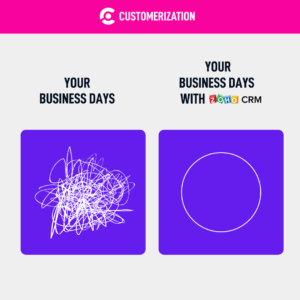Zoho CRM is more than a tool for keeping track of your connections and clients. It is the best approach to evaluating performance and remaining in contact with your clients.
It makes it simple to automate your sales and marketing and allows you to have complete control over your customer communications. The practicality and resourcefulness of Zoho match the needs of small and large businesses that require scalable, customized solutions.
This Zoho CRM implementation checklist is the ultimate CRM implementation guide you need to get started with Zoho.
What is Zoho implementation?
Zoho implementation is the process of integrating Zoho with your business in such a way that it boosts your productivity and improves your relationship with your customers. It is a great way to ensure you provide the best customer experience.
Zoho CRM Implementation Checklist
So you’ve been wondering, What are the keys to successful CRM implementation? Well, this checklist is here to save the day. This checklist can be regarded as your very own Zoho CRM implementation plan.
✅ Planning & discovery
This is the exploration phase, where you determine your reason for switching to a new CRM, the features you want it to have, the time it would take, the financial aspect, and the effort-related commitment you’re willing to make.
The discovery phase enables you to comprehend the issues you’re seeking to address by converting to Zoho CRM planning, the capabilities Zoho provides that can handle them, why it’s your best choice, and how to manage your conversion systematically.
✅ Determining the requirements and scope.
The next step is to determine your scope by deciding:
- The number of licenses you need (To do this, you need to have a good knowledge of the problems the Zoho CRM platform can help you solve.)
- The price tier that provides the functionality you require and can contain your data volume
- Third-party applications or integrations you’ll have to spend money on
- Your Zoho CRM version (custom construction or the standard solution)
- The amount of information you need to transfer to the Zoho platform (To select the optimal solution, you must match the needs of your firm to the available Zoho CRM solutions.)
✅ Onboarding Users and Configuring User Permissions
Setting up the initial users is the next item on your checklist for implementing Zoho CRM. Anyone with direct access to the system through a username and password is referred to as a user, who is almost always an employee. Which features they can utilize and what data they have access to will depend on permission.
Roles and Profiles are two parts that have permission; profiles determine what users can perform, and roles decide which data they may view. The hierarchy of your business determines roles. Users can be added to the roles that correspond to them, and you can specify to whom they report.
Module, field, and home screen customization
Next, it’s time to choose which Zoho CRM features to modify. Zoho CRM can be customized in more ways than one can imagine, and some of these customization options or specifications won’t be apparent until you begin using the system. All of the customization options are so many so let’s focus on the one with modules and fields that most businesses will scan first. Although the CRM can be utilized right out of the box, it is far more helpful when it is tailored to your company’s needs regarding the data you need to capture and the methods you will use.
Removing CRM features that are useless for your business is a crucial component of the first customization that will significantly aid user adoption. This entails deactivating inactive modules and clearing out unnecessary fields from your active modules.
✅ Importing Data/ Data Migration
The next step for most businesses switching to a new CRM is to import their current data. Data import into Zoho CRM can be done in one of two methods. Utilize the migration option to move your data from the other CRM or import your data by uploading a file.
✅ Basic Automation
In Zoho CRM, there are different kinds of automation. Let’s cover the essentials in this checklist for implementing Zoho CRM.
In CRM, you may assign records to specific users using Assignment Rules. Records which are automatically uploaded to CRM, such as new leads added via your website integration, are subject to assignment rules.
Within CRM, we may automate routine processes using workflow rules. A task generated whenever a lead is received from a particular source illustrates a workflow rule.
Let’s briefly highlight CRM’s strong workflow rules and automation features.
First, focus on blueprints, another automation tool. Though creating your Blueprints will take some time, when you’re starting is an excellent time to begin considering how to integrate Blueprints into your CRM.
You may create a method to physically lead your users through the CRM processes using Zoho CRM Blueprint and our business process flow as a guide. The Blueprint allows you to model every process in your company flow and will be very functional going ahead.
It is possible to gather the mandatory data needed at each transition in the Blueprint, start automation like task creation and notice sending, give information to the CRM user, execute escalations, approve requests, and do various more actions.
✅ Crosscheck Data
Make sure nothing was damaged or damaged in transit after transferring your data to Zoho.
Here, you manually cross-reference various records, contact databases, phone numbers, call recordings, deal details, files, and attachments to see whether they correspond to what’s in your old CRM.
Even better, you may migrate a small amount of data to your Zoho CRM first and check it before transferring your complete database.
With the above CRM implementation guide, you can quickly start using Zoho to create an excellent customer experience while boosting productivity.
But there’s an even better way to do this, a Zoho CRM implementation partner. With customerization, you can seemingly go through the CRM implementation phase and have the best experience.




